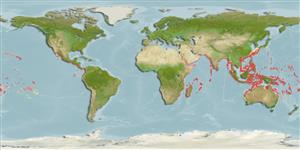Common names from other countries
Environment: milieu / climate zone / depth range / distribution range
Ecologie
marien rifbewoner; standvastig; diepte 100 - 200 m (Ref. 86942). Deep-water; 35°N - 34°S
Indo-West Pacific: tropical, known only from a few scattered localities.
Lengte bij maturiteit / Grootte / Gewicht / Leeftijd
Maturity: Lm 31.0 range ? - ? cm
Max length : 55.0 cm TL mannelijk / geslacht onbekend; (Ref. 2295); common length : 35.0 cm TL mannelijk / geslacht onbekend; (Ref. 2295)
Dorsale stekels (totaal): 10; Dorsale zachte stralen (totaal): 10; Anale stekels 3; Anale zachte stralen: 10. The inner surface of the pectoral fin axil without scales. Overall color is silvery-gray with yellowish suffusion; scale margins are narrowly brownish. Indistinct dark blotches or bars are sometimes apparent on the body. The lips are whitish to yellow. The fins are yellow, faint brown spotting may be present on soft dorsal, anal, and caudal fins. A narrow blackish bar runs across the base of the pectoral fin.
Inhabits the outer edge of the continental shelf. Feeds on bottom-living invertebrates and small fishes. Caught mainly with bottom longlines and bottom trawls (Ref. 9775).
Levenscyclus en paargedrag
Maturiteit | Voortplanting | Paaien | Eieren | Fecunditeit | Larven
Carpenter, K.E. and G.R. Allen, 1989. FAO Species Catalogue. Vol. 9. Emperor fishes and large-eye breams of the world (family Lethrinidae). An annotated and illustrated catalogue of lethrinid species known to date. FAO Fish. Synop. 125(9):118 p. Rome: FAO. (Ref. 2295)
Status op de Rode Lijst van het IUCN (Ref. 130435)
CITES (Ref. 128078)
Not Evaluated
Gevaar voor de mens
Harmless
Gebruik door de mens
Visserij: van minder commercieel belang
Meer informatie
ReferentiesAquacultuurAquacultuurprofielKweeklijnenGeneticaElectrophoresesErfelijkheidZiektesVerwerkingMassaconversie
Tools
Speciale rapporten
Download XML
Internetbronnen
Estimates based on models
Preferred temperature (Ref.
115969): 14.4 - 24.3, mean 19.9 (based on 186 cells).
Fylogenetische diversiteitsindex (Ref.
82804): PD
50 = 1.0000 [Uniqueness, from 0.5 = low to 2.0 = high].
Bayesian length-weight: a=0.01862 (0.00665 - 0.05211), b=2.96 (2.72 - 3.20), in cm Total Length, based on LWR estimates for this (Sub)family-body shape (Ref.
93245).
Trofisch niveau (Ref.
69278): 3.7 ±0.52 se; based on food items.
Weerstandsvermogen (Ref.
120179): Gemiddeld, minimale populatieverdubbelingstijd 1,4-4,4 jaar (Preliminary K or Fecundity.).
Fishing Vulnerability (Ref.
59153): Low to moderate vulnerability (28 of 100).
